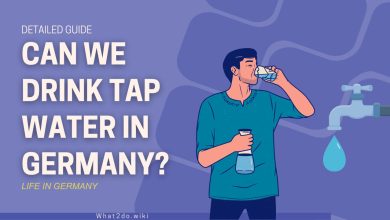Moving to Germany brings many new experiences, and one of them is mastering the complex but highly effective recycling system. Recycling isn’t just a trend here—it’s a cultural value, and Germany consistently leads global recycling efforts. In this guide, we’ll help you understand everything about trash disposal in Germany, from color-coded bins to avoiding hefty fines. This guide will ensure you understand not only the basic rules but also the nuances that make Germany’s recycling system one of the most effective in the world.
Recycling in Germany is more than just a government mandate—it’s a lifestyle deeply ingrained in the everyday lives of its citizens. Whether you are in a bustling city like Berlin or a quaint village in Bavaria, recycling bins are a common sight. Proper waste separation is not just about avoiding fines; it’s about actively participating in efforts to protect the environment, conserve resources, and create a sustainable future. This guide will also explore how you can efficiently fit into this system without feeling overwhelmed.
Key Points at a Glance
- Germany leads with a 69.1% recycling rate in the EU.
- Trash separation is a cultural norm; improper disposal can lead to fines of up to €1,500.
- Each household typically uses multiple bins for paper, plastics, organic waste, and general waste.
- The ‘Pfand’ system for bottles and cans encourages recycling through refunds.
- Understanding waste categories and their respective bins can save you money and protect the environment.
- Public cooperation plays a major role in ensuring the system’s success.
- There are different collection protocols for various types of waste, such as electronics and bulky items.
Why Does Germany Recycle Well?
Germany’s impressive recycling rate stems from strict governmental policies, community enforcement, and cultural habits ingrained from a young age. Germans take waste separation seriously, with households often having up to four distinct bins. The German government has also implemented a series of educational programs in schools, ensuring children grow up understanding the importance of recycling. Companies are encouraged to minimize waste through various green initiatives, and local municipalities are often at the forefront of organizing community clean-up events.
By learning the system, not only will you avoid fines, but you’ll also gain a deeper appreciation of Germany’s sustainable culture. Participating in this well-orchestrated recycling plan is like being part of a collective effort to protect our planet.
How Is Trash Separated in Germany?
Trash separation in Germany is done meticulously, with different types of waste being allocated to specific colored bins. Let’s break down each bin, what goes into it, and why these categories matter.
Blue or Green Trash Bin (Paper and Cardboard)
Depending on the region, blue or green bins (Blaue Tonne or Grüne Tonne) are designated for paper and cardboard. This includes items like newspapers, magazines, egg cartons, and clean cardboard. Properly separating paper products ensures that they can be recycled efficiently, saving resources and reducing the need for raw material production.
What Shouldn’t Go in the Blue Container?
- Beverage cartons go in the yellow bin.
- Soiled paper products and used paper towels belong in the black bin.
For instance, used napkins or pizza boxes with food residue should not be disposed of in the paper bin because contaminants hinder the recycling process. Learning to distinguish clean recyclables from contaminated ones is a key part of effective waste separation.
Yellow Bin (Plastics and Soft Metals)
The yellow bin (Gelbe Tonne) or yellow bag (Gelber Sack) is used for soft metals, plastics, and packaging with the Green Dot (Der Grüne Punkt). Items should be cleaned before being tossed in. This helps ensure that contaminants do not spoil the recyclable quality of other items.
What Goes in the Yellow Bin?
- Plastic bottles (no deposit)
- Cans
- Yogurt containers
- Aluminum foil
- Tetra-paks and coated packaging
What Is Not Allowed in The Yellow Bin?
- Batteries and light bulbs, which have separate disposal protocols.
- Styrofoam, which goes into the black bin.
- Non-packaging plastics like toys or plastic furniture.
Cleaning plastic and metal packaging before disposal is encouraged because dirty items can spoil an entire batch of recycling. Some municipalities even require rinsing as part of their official guidelines. By taking this extra step, you contribute to the efficiency and effectiveness of the recycling system.
Organic/Bio Waste Bin
If it’s biodegradable, it belongs in the organic waste bin, also known as the Biotonne. This includes food scraps, coffee filters, and garden waste. In many areas, this waste is converted into compost or bioenergy, making proper separation beneficial for both the environment and the community.
What Goes in the Organic Bin?
- Coffee grounds and filters
- Eggshells
- Vegetable peelings
- Garden clippings
- Leftover bread and similar biodegradable items
What Should Not Go in the Organic Bin?
- Plastic bags (even biodegradable ones unless specified by your city)
- Animal bones
- Cigarette butts
Proper use of the organic bin ensures that valuable nutrients can be returned to the soil, reducing the need for chemical fertilizers. Germany’s focus on converting organic waste into renewable energy is part of the reason they have one of the highest recycling rates globally.
Residual Waste Bin
The black bin (Restmüll) is for everything else—from sanitary products to soiled paper. This bin is often the catch-all for waste that doesn’t fit into the other categories. Unlike other types of waste, the contents of the black bin are typically incinerated rather than recycled, which is why minimizing what goes in this bin is crucial.
Examples of Items for the Black Bin
- Used tissues and diapers
- Cigarette butts
- Vacuum cleaner bags
- Broken ceramics
By properly sorting out recyclable materials, you can help ensure that the black bin only contains non-recyclable waste, reducing the volume of waste that ends up in landfills or incinerators.

Glass and Special Waste Disposal
Glass bottles and jars need to be separated by color and taken to public collection containers (Glascontainer). You can easily find their locations by searching online using “Glascontainer + your city.” Typically, these bins are divided into sections for white, green, and brown glass, ensuring effective recycling.
Glass waste should be disposed of in the appropriate container to prevent contamination. For instance, colored glass mixed with clear glass can make it difficult to recycle effectively. Additionally, items like light bulbs, mirrors, or porcelain should never go in the glass container, as they have different chemical compositions and recycling processes.
Specific Collection Points for Hazardous Items
Certain items, such as light bulbs, batteries, and electronics, require special handling. Batteries can often be dropped off at collection points found in supermarkets, while electronics can be taken to designated recycling centers. Proper disposal of these items prevents hazardous substances from contaminating the environment.
Waste Management Calendar in Germany
Every German city issues a waste management calendar (Abfallkalender) that details collection days for different waste types. These calendars are often delivered to households or available online. Some local authorities also offer a mobile app for easy access to this information. Knowing when to put out each type of waste ensures that recycling services operate smoothly and efficiently.
Waste calendars will often provide additional guidance on special collection days for items like Christmas trees, hazardous household waste, and bulky items. Keeping up with these dates is important to ensure that your waste is handled properly and that you don’t miss any collection opportunities.
Recyclable Waste Fines
Improper waste disposal can lead to fines ranging from €10 to €1,500, depending on the severity and the state regulations. It’s crucial to follow proper disposal guidelines to avoid these penalties. The strictness of these penalties reflects the importance of recycling to German society.
The fines are also used as a deterrent to ensure compliance, with neighbors sometimes reporting improper disposal practices. Thus, learning the correct recycling procedures is beneficial not only for avoiding fines but also for fitting in harmoniously within your community.
Deposit System (Pfand)
Certain plastic and glass bottles are subject to a deposit (Pfand), refundable when returned to a supermarket collection machine. Pfand values range from 8 to 25 cents per bottle or can, incentivizing recycling. The Pfand system is a significant part of Germany’s recycling success, encouraging citizens to return bottles instead of throwing them away.
These deposit machines are often found at the entrances of major supermarkets, such as Rewe, Aldi, and Edeka. Once returned, the machine issues a receipt, which can be used to offset your grocery bill. This creates an easy and practical way to encourage recycling.
Disposal of Electronics, Batteries, Shoes, and Clothes
- Electronics: Larger electronics, such as old TVs or microwaves, can be dropped off at stores like MediaMarkt or specialized e-waste collection centers. Many municipalities also have designated days for electronic waste collection, where you can dispose of these items without any additional fees.
- Batteries: Supermarkets like Aldi and Lidl have battery recycling points. Used batteries contain hazardous materials, and disposing of them correctly prevents these materials from contaminating the environment.
- Old Clothes: Use clothing donation bins (Altkleidersammlung) found near local recycling points. Alternatively, donate via the German Clothing Foundation by packing your items in a box and dropping them off at a post office. This helps reduce textile waste and supports charitable organizations.
Many local councils collaborate with non-profits to collect clothing that is still usable. This contributes to both environmental conservation and social good, as the clothes are distributed to those in need.
Lacquers, Paint, and Christmas Trees
Lacquer and paint residues should be disposed of at hardware stores like Obi or Hornbach, which accept small quantities of hazardous waste for proper treatment. Leftover paints and lacquers contain chemicals that can be harmful to the environment if not handled properly.
For Christmas trees, check the Abfallkalender for pickup dates in your area. Typically, Christmas tree collection takes place in January, where you simply leave your tree on the curbside for pickup. Trees must be free from decorations, tinsel, or artificial snow to be properly recycled.
Bulky Waste (Sperrmüll)
Bulky waste, or Sperrmüll, includes large items like furniture and appliances that can’t fit into standard bins. Schedule a pickup with your local garbage service in advance. While this service is often free, improper disposal can result in fines up to €2,500.
To arrange for bulky waste collection, you usually need to register online or call your local waste management service. Items should be placed on the curb the night before collection, ensuring they are not obstructing traffic or pathways. Sometimes, people pick up reusable items left out for Sperrmüll, contributing to a kind of informal recycling.
Conclusion
Germany’s comprehensive waste management system ensures that recycling is a shared responsibility. From mandatory trash separation to community enforcement, recycling in Germany is deeply rooted in its culture. Mastering this system can not only help you avoid fines but also contribute to one of the world’s best recycling efforts. Remember, it’s more than just following the rules—it’s about becoming part of a larger movement towards sustainability.
With efficient recycling and a clear structure for waste separation, Germany sets a high bar for environmental responsibility. This system not only reduces waste going to landfills but also supports the production of renewable energy, compost, and recyclable materials. By adhering to these practices, you are actively contributing to a more sustainable future and supporting a culture that values environmental stewardship.
If you found this guide helpful, consider subscribing to our newsletter for more insights into living in Germany, including tips on navigating bureaucracy, mastering public transport, and making the most of your time here. Together, let’s make sustainable living easier. Join our community today, and be a part of a growing movement toward a greener future.




